
table of contents
- Tomato diseases
- Parasitic diseases
- More tomato diseases
- Green or yellow collar diseases
- Magnesium deficiency diseases
- Tomato diseases from cold
Tomatoes are one of the most popular vegetables grown in gardens and on balconies. Although they are not very sensitive, they can make tomato diseases inedible and, in the worst case, destroy a whole year's harvest. Typical features make it easy to identify the various diseases and these can be prevented with practical tips and professional care instructions.
Tomato diseases
Tomatoes are relatively easy to grow and often delight hobby gardeners with an abundant harvest. It is annoying when tomato diseases spread. There are often care errors, but even in the best conditions, tomatoes are not immune to diseases and pests. The damage can be different. The key here is to recognize them quickly in order to initiate the right treatment and, ideally, to save your harvest. With the right care tips, you can prevent tomato diseases.
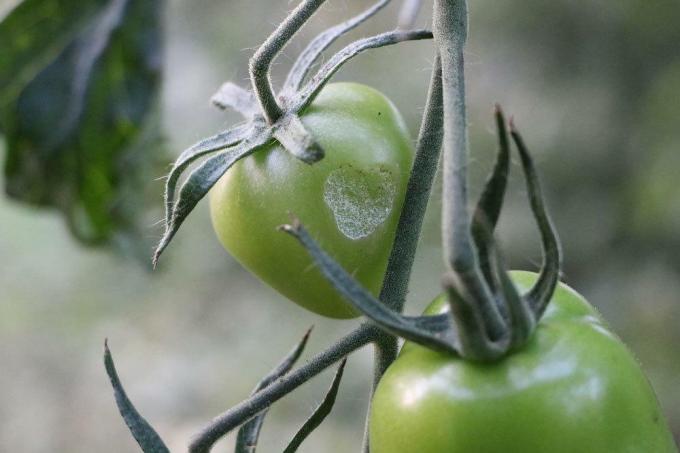
Fungal diseases
Care tips for prevention
- Keep leaves dry when watering
- early removal of side shoots
- Separate the tomatoes with a stick or string
- Disinfect sticks at least once a year, preferably after the gardening season
Spot disease (Alternaria solani)
The dry spot disease is a fungal disease. It is one of the most common types of fungus in tomato diseases. The mushroom is usually active between June and August. The fungal pathogen "Alternaria solani" is transmitted with the wind. These settle preferably on wooden sticks and in the ground. From there, the fungus spreads to the tips of the leaves.
Recognition:
- Fungal infestation usually begins at the bottom and slowly pulls up
- black spots form on the upper side of the leaves
- black spots are mainly bordered by leaf veins
- the calyx area and the fruits begin to rot and mold
- Leaves curl up and fall off
- Tomatoes become soft to mushy
Combat:
Once this fungus has settled, the plant can only be saved if there is little damage and the spread is limited. Treatment is always advisable to contain the fungus and prevent transmission to neighboring plants. You can do this with a fungicide such as CELAFLOR® Vegetable Mushroom Free Saprol. You should also check the location. If the tomatoes are too warm at over 20 degrees Celsius and too moist, this can lead to dry spots and other diseases. Transplanting is dry soil and a cooler environment will keep the fungus at bay.
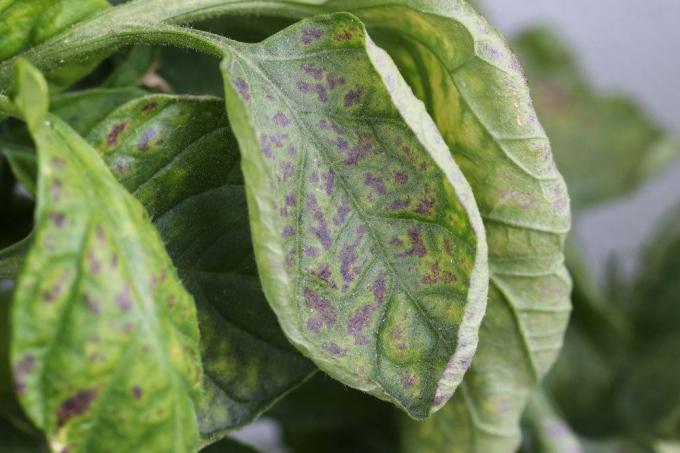
TIP: In principle, do not dispose of tomato plants with fungal diseases that cannot be saved on the compost, but in the household waste.
Preventive measures:
- Do not plant tomatoes next to potatoes - these attract the Alternaria solani pathogen
- Cut leaves regularly to a height of between 25 and 30 centimeters
- Remove the tomato plant regularly (remove new shoots)
- ensure good ventilation and a dry location
Powdery mildew (Oidium neolycopersici)
Powdery mildew includes a type of fungus that is widespread among tomato diseases. This usually affects the leaves as well as the plant tissue. If left untreated, it can cause serious damage that can lead to the death of the tomato plant. It usually occurs between May and August.

Recognition:
- Infestation mainly on the leaves and petioles
- white, sticky spots on the tops of the leaves
- white spots merge with each other with increasing duration of the disease
- Leaves turn yellow and brown before drying up
- Stunted growth
Combat:
A very effective and ecological control agent is the soapy water made from natural soap without additives. Make a highly concentrated lye from the soap and water. Use this to spray the affected plants so that they are dripping wet. Repeat the process again after two or three days. If fungal spores still show, you can spray again with the soapy water after a week. By then at the latest, the powdery mildew should have died.
Alternatively, you can use a fungicide. Here you have to make sure that it is suitable for edible vegetables, otherwise you will lose the harvest. Parts of plants that show signs of damage from fungal diseases should in principle always be checked for Treatment should be cut off, regardless of whether treatment with soapy water or a fungicide took place.
Preventive measures:
- Choose varieties that are more resistant to fungal tomato diseases, such as Phantasia F1
- ensure constant ambient temperatures
- if possible, keep the humidity below 70 percent
- Potassium-containing fertilizers prevent infestation
Gray mold (botrytis cinerea)
A gray mold is a mold that is transmitted by the pathogen Botrytis cinerea. This fungus is also known as ghost spot disease. The pathological damage caused by diseases of this fungus extends over the entire plant, including the tomato fruits. It spreads mainly between May and September and likes high humidity, which is why it usually feels particularly comfortable in greenhouses.

Recognize:
- gray spots on the leaves and on the stems of the tomatoes
- in the advanced stage, a carpet of spores spreads
- Stems and tomatoes go moldy
Combat:
The only tomatoes that can be saved are those of which the tissue has not been attacked. Otherwise the plant must be completely disposed of. If there is still undamaged tissue, you can take the following measures to treat this type of mushroom tomato disease.
- Cut back all parts of the plant to the healthy area
- in the case of advanced infestation, fungicide such as vegetable-fungus-free Infinito from Bayer
- Discard moldy tomatoes
Preventive measures:
- away from fungus-preferred plants such as strawberries, Raspberries or salads
- Provide sufficient air circulation in the greenhouse to reduce humidity
- if tomatoes are covered, they dry faster (moisture reduction)
- Plant in nutrient-rich soil to keep immune systems strong
- Maintain a planting distance of at least 40 centimeters to large tomato varieties
- do not wet the leaves while watering
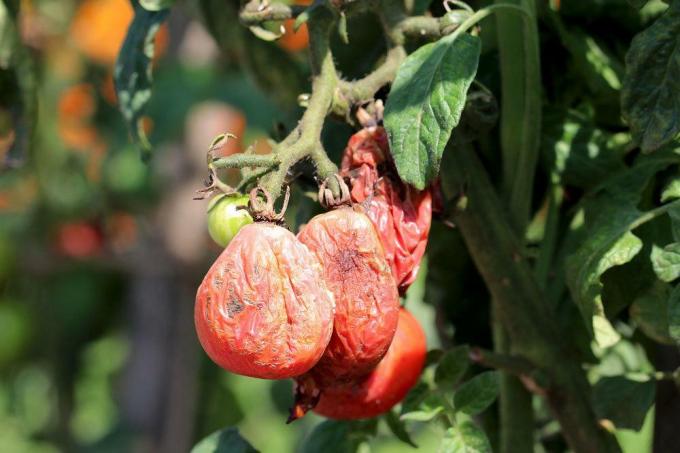
Didymella fruit and stem rot (Didymella lycopersici)
Didymella lycopersici is one of the tomato diseases caused by a fungal infection. Transmission takes place via the wind and rain. The fungal spores can penetrate the inside through wounds and the stalks on the tomatoes.
Recognize:
- Sunken bark tissue on the stem directly above the soil layer
- black colored bark tissue on the lower stem
- in the advanced stage the plant wilts
- Tomatoes form dark discolorations at the base of the stem and can start to mold
- Leaves turn increasingly yellow
Combat:
The tomato plant can be saved from dying by a treatment as it is described under "dry spot disease", provided the damage is limited. Affected tomatoes can no longer be used and disposed of.
Preventive measures:
- Plant tomatoes out of the wind
- do not use seeds from infested plants
- avoid injuries / wounds from sticks and cords
- Regularly clean the plant sticks and replace the cords
- Rotate crops regularly
Late blight (Phytophthora infestans)
The late blight is one of the fungal diseases with the pathogen called Phytophthora infestans. This fungus occurs mainly in potatoes and is carried on to tomatoes by the wind. Temperatures between 18 and 20 degrees Celsius in conjunction with high humidity offer optimal conditions for rapid expansion. It almost only affects outdoor tomatoes.
Recognize:
- the first symptoms in the form of brown, sunken, hard spots on the fruits
- initially gray-green spots, which then turn to black
- Moisture favors the formation of gray-white fungus deposits on the underside of the leaves
- Leaves die off
Combat:
You should react quickly, because the further this type of fungal diseases can quickly die off the plant and, in the worst case, entire beds. Detected at an early stage, this egg fungus can be treated with a pesticide such as Atempo® Kupfer-Fungzfrei von Neudorff® can also be used on potatoes to prevent the fungus from spreading impede. Far advanced damage patterns can only be disposed of by the plant. The tomatoes are no longer suitable for consumption from the time of infestation.
Preventive measures:
- Do not plant / seed tomatoes near new potatoes
- Do not wet plant parts above the surface of the earth and keep them dry
- Choose a location on the warm south side, ideally with wind and rain protection
- ensure sufficient planting distance of around 50 centimeters (promotes rapid drying)
TIP: If you put a flower pot with a drain hole in the ground next to the plant, you can use it to water the soil without hitting the leaves or stems with water. Make sure, however, that the edge of the pot is not inserted at ground level so that useful bugs cannot fall into it.
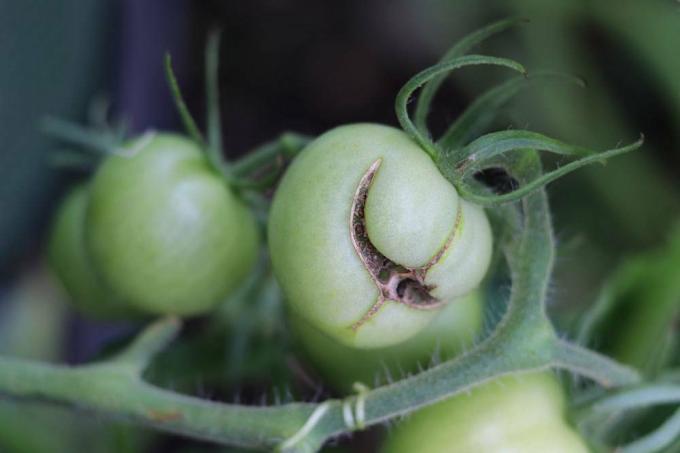
Parasitic diseases
A balance between plantings and beneficial animals is welcome in tomato planting. They protect against numerous tomato diseases caused by pests. Nevertheless, beneficial insects are not fundamentally a guarantee that parasites will stay at a safe distance. Many of them cause damaging images, so a quick response is required.
Whitefly (Trialeurodes vaporariorum)
The whitefly is a whitefly and often causes tomato diseases with extensive plant damage. This pest occurs predominantly in greenhouses.
The adult animals lay numerous eggs under optimal temperature conditions, from which larvae develop, which ultimately grow into whiteflies. The propagation takes place within about six to seven weeks. Here you should have spotted the whitefly near your tomatoes beforehand.
Recognize:
- about two millimeters long insects with a white body
- are usually on the underside of the leaves
- if they are jolted, they fly away from the plant
- often occur in higher numbers
- yellow speckles on the leaves
- Plant increasingly loses vitality
- increased leaf waste
- forms sticky honeydew
- Honeydew promotes other tomato diseases, such as sooty mildew, which form black spots on the leaves
Combat:
- by beneficial insects such as parasitic wasps or ladybirds (available from specialist gardeners)
- Yellow stickers as an insecticide promise a high level of effectiveness, especially against eggs and larvae
- Spray with soft soap solution: Mix 1 tbsp soft soap in one liter of water plus with 100 milliliters of alcohol
TIP: If you pay attention to the suitability for vegetables when buying yellow stickers, you can wash the tomatoes vigorously after the treatment and consume them safely. In the case of soft soap treatment, washing removes any residues that could affect the taste.

Preventive measures:
- The ambient temperature should be below 25 degrees Celsius to prevent reproduction
- Set up an insect hotel to attract beneficial insects
- Do not plant tomatoes in the vicinity of cabbage vegetables (whiteflies are particularly fond of cabbage)
Spider mites
Spider mites prefer warm, dry climates, although adult specimens can easily survive winter. They damage the plant by removing the life energy from the leaves while they are sucking food. In the worst case, this can cause the tomatoes to die. They are usually more common in greenhouses than outdoors.
Recognize:
- white animals up to one millimeter in size
- settle mainly on the underside of the leaves
- Fine webs are spun on leaves and stems for protection
- ensure a yellow leaf discoloration
- Leaves dry off

Combat:
Since the greatest enemy of spider mites is moisture, a powerful shower of water helps in many ways to combat it. A translucent plastic film stretched over it keeps the moisture longer. However, this should not last longer than a day, otherwise the risk of fungal diseases is increased. The moist method should only be used during warm, dry days so that the tomatoes can dry off quickly.
If the infestation is more severe, we recommend using a neem oil product, which sticks the respiratory organs of the spider mites and causes them to die.
Preventive measures:
- Ensure a balanced humidity ratio in greenhouses
- keep the soil of the tomatoes evenly moist
- Regular fertilization and optimal care strengthen the immune system
More tomato diseases
In order to produce harmful images in tomatoes, tomato diseases that are caused by fungi, bacteria or pests do not necessarily have to be present. In some cases these are due to poor conditions and other factors that do not meet the minimum requirements of the plants.
Spoon petals
One of the typical and often occurring tomato diseases is leaf rolling, which in botany is called spoon-leafing. This leads to a spoon-like curling of the leaves up or down. The main cause is usually incorrect maintenance or a suboptimal location.
Causes:
- Soil over-fertilized, so that too much nutrients (nitrate)
- too exhausted (new shoots removed)
- Stood too dry for too long

Treatment:
Here there is only the possibility of creating better conditions, adapting the fertilizer application to requirements, to water regularly and, as a preventive measure, be more careful when cutting off new shoots in the future proceed. Once the tomatoes have received enough water again and the fertilizer content has slowly decreased in the soil over time, the plants usually recover on their own.
Tomatoes black inside
If your tomatoes turn black when you cut them, this is probably due to a lack of calcium. If the soil conditions are optimal, it can still happen that the calcium in it is not transported into the interior of the plant. This can, for example, be the result of too compacted soil, which generally encourages tomato diseases. This disrupts the ripening process and the tomatoes turn black on the inside. In addition, so-called flower end rot is increasingly developing at the flower roots.

If you work algae lime into the soil for diseases like this, the soil structure improves and the absorption of nutrients is clearly stimulated, so that calcium is also abundantly absorbed can. Damaged parts of the plant must be cut off.
Flower end rot
Blossom end rot is a special type of tomato disease that shows images of black spots forming on the leaves and tomatoes. Often the optical impression arises that the tomatoes are rotten.
Blossom end rot is also a result of calcium deficiency, such as that caused by compacted soil and restricted nutrient transport. Excessive humidity and prolonged drought favor a progressive damage pattern. It is advisable to proceed in the same way as under "Tomatoes black inside" in order to optimize the nutrient transport again. Damaged areas are to be removed from the plant. If the tomatoes are affected, they should no longer be eaten.

As a preventive measure, you should occasionally water with hard water, only organic fertilizers such as compost and measure the pH so that you prevent a new calcium deficiency if necessary can.
Tomatoes inside white
Have you picked beautifully colored tomatoes, cut them open and they are white on the inside? Then you will usually not find an answer under the tomato diseases, but that may be due to an ambient temperature that is too high. Here botanists speak of “hot” or “cooked”. This happens more often when your tomatoes are exposed to blazing sun or hot midday sun in midsummer. Of course, tomatoes can turn white inside in a greenhouse that is much too warm and become one of the most unpopular diseases. This is usually due to bad climatic conditions in the greenhouse, where none Air circulation prevails and the hot sun unfiltered without additional sun protection on the plants impacts.
To prevent this, tomatoes should be planted in a location where they are not exposed to hot, direct sunlight. In an emergency, sun protection must be added afterwards. The tomatoes are usually edible. The white areas can only harden at most.
Green or yellow collar diseases
Diseases such as green and yellow collars result in permanent immaturity, no matter how long the tomato remains on the plant.
Green and money collar diseases are caused by excessive solar radiation that hits the plant directly and / or a lack of potassium or too much nitrogen. The latter mainly shows a yellow coloration of the collar.

Clear features are:
- yellow or green collar
- all tomatoes are affected
- a clear difference in ripeness can be seen with ripe fruits
- remain hard in their consistency
Preventive measures:
- look for a more optimal location where direct sunlight is not possible
- do not use too much or no lime-free irrigation water
- Choose more suitable tomato varieties when a sunny location is unavoidable, such as Culina or Vitella
- Do not use the "Harzfeuer" variety in a sunny location (is particularly susceptible to sun-related diseases)
- Put up sun protection if necessary
- Measure the pH value regularly and fertilize algae lime if there is a lack of lime or acidic soil
- do not use nitrogenous fertilizers
Magnesium deficiency diseases
Signs of tomato diseases caused by a magnesium deficiency may appear more often. Usually this consists of sandy, light and acidic soil.
A magnesium deficiency is made clear by the following characteristics:
- color lightening predominantly on the lower and middle leaves
- Yellow discoloration forms between the leaf veins
- Main leaf veins remain unaffected
- at an advanced stage, the leaves turn brown and dry up
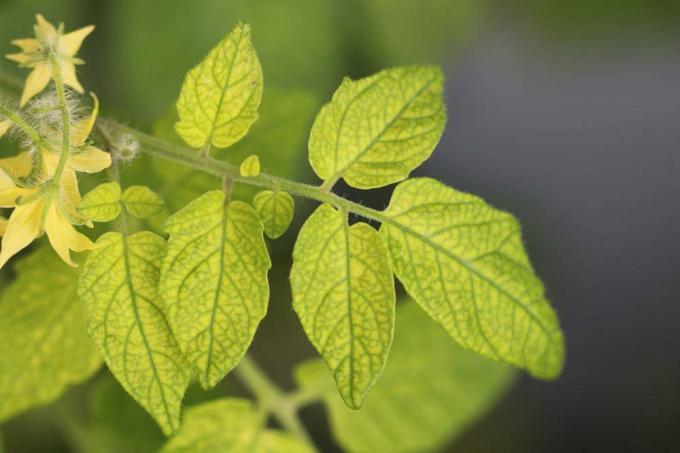
Cause and Treatment:
A magnesium deficiency is usually the result of an unbalanced ratio to potassium and too high a nitrogen content. This has a strong influence on the absorption of magnesium by the roots and a deficiency symptom can occur. Nitrogen in particular slows down the supply of nutrients via the roots.
Epsom salt is an effective measure in acidic soils, as is algae lime, which has a high calcium carbonate content and promotes nutrient absorption by tomatoes.
Tomato diseases from cold
If tomatoes are too cold, damage can occur, which can sometimes lead to the suspicion of the worst tomato diseases. Indeed, the cold can cause death, but with optimal preparation it is easy to prevent it.
Recognize:
- lower leaves turn light in color between the leaf veins
- in the further course they turn brown to black and the plant tissue dies (necrosis)
- Leaves dry up
- the damage pattern moves upwards and gradually causes the plant to continue to die
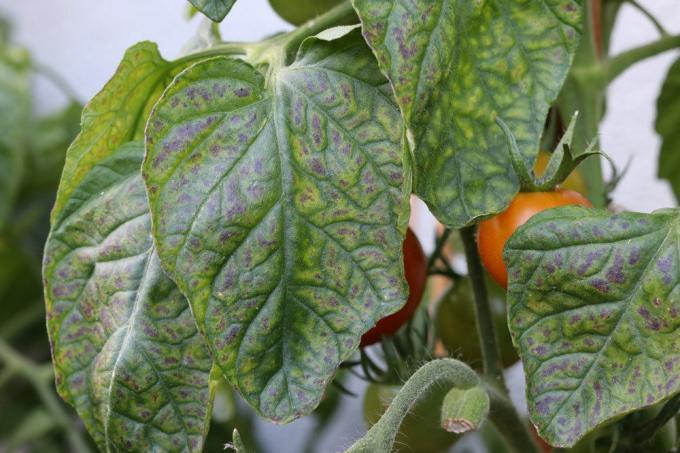
Combat:
The less frost damage has progressed, the higher the success rate if you cut off affected parts of the plant. At the same time, the plants regenerate themselves at warmer temperatures, provided they have been well cared for, have a strong immune system and still have sufficient energy. Nutrients also support regeneration.
Preventive measures:
- prevent temperatures below six degrees Celsius
- temporarily cover young and potted plants with foils in the event of expected temperature drops
- ensure a good nutrient content in the soil to prevent deficiency symptoms



